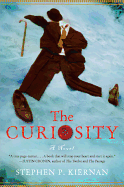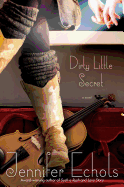 Ancient Light by John Banville (Vintage International, $15)
Ancient Light by John Banville (Vintage International, $15)
Banville readers have met Alexander Cleave before, in the novel Eclipse. This time, the stage actor is invited to star in a movie, which sets in motion a search for some ancient light that might illuminate his past. Is there any difference between memory and invention? Booker Prize winner John Banville probes this question in exquisite prose.
The Beautiful Mystery by Louise Penny (Minotaur Books, $15)
In the eighth book in the Inspector Gamache series, he and his protégé Jean-Guy Beauvoir investigate the brutal murder of a prior within the isolated and mysterious monastery of Saint-Gilbert-Entre-les-Loups. It's a haunting tale of religious passion, and Penny creates an elaborate and intricate mystery, weaving together various plots in a thematic tapestry that mirrors the complex chants she writes of so beautifully.
 A Fistful of Collars by Spencer Quinn (Atria, $15)
A Fistful of Collars by Spencer Quinn (Atria, $15)
Since 2009, when Quinn introduced detective Bernie Little and his canine partner Chet in Dog on It, the duo has cracked every case--but not, as Chet reminds us, without their share of close calls. Chet--lovable, devoted, wily, brave—doesn't talk; he's a thinking (and hilariously unreliable) narrator, so the reader sees the big picture even if Bernie doesn't. This time, the trouble-prone movie star they're assigned to keep straight while he's filming in town leads them down shady alleys, into the desert and to more than one unsolved murder.
Slow Apocalypse by John Varley (Ace, $7.99)
Dystopian novelists are often less interested in how the world fell apart than in exploring the grim, desolate landscapes left behind. John Varley (a multiple Hugo and Nebula award winner) has thought a lot about the early stages of collapse, though, and his precise details make Slow Apocalypse read like a play-by-play end times scenario as he chronicles one family's mental and emotional adaptation to their disastrous conditions.
 Something Red by Douglas Nicholas (Atria Books, $16)
Something Red by Douglas Nicholas (Atria Books, $16)
In his first novel, Douglas Nicholas channels a fiercer beast than his usual poetic muse, producing a remarkable variation on the perennial werewolf tale. Set in 13th-century England, the novel chronicles the journey of a boy named Hob, and three companions, as they are stalked by something terrifying in the wintry forest. There are moments written with such startling beauty that they imbue the larger story with a kind of perverse joy, making this coming-of-age story not simply a matter of fear and necessity, but of strength and love.
Sweet Tooth by Ian McEwan (Anchor, $15.95)
Ian McEwan hasn't written a novel with a female protagonist since Atonement. In Sweet Tooth, he shows once again that he can inhabit the female voice completely. Serena Frome has a job with the British intelligence service MI5; one day, because she is a "literary type," she is recruited for a special project that aims to co-opt writers with leftish tendencies and steer them away from anti-Western bias. McEwan's reflections on 1970s England and intelligence capers all come together to make one really good spy novel.
You & Me by Padgett Powell (Ecco, $13.99)
Padgett Powell (Edisto) is back with You & Me--a Southern nod toward Vladimir and Estragon, those two great talkers in Waiting for Godot. Call it absurdist, call it experimental fiction, postmodernist; whatever it is, just sit back and enjoy the ride. In endless dialogue, the pair talk about the definitions of words they like (trepanning); they expound on girls and women lost and found; inevitably, they begin to feel the horizon shortening and decide that they must "live every day of our lives as if it's the last day of our life. Let's see: that's LEDOOLAIITLDOOL. It sounds like a Mayan god." But don't be fooled into thinking that this is a trivial book. Stay with it and the payoffs are marvelous.
The Joy Brigade by Martin Limón (Soho Crime, $14.95)
Sergeant George Sueño is a military police officer in the Korean DMZ. In The Joy Brigade, he is sent to North Korea on a mission that will test every bit of his strength and intelligence. The year is 1972: Kim Il-Sung is looking to retire, but he wants to invade South Korea and reunite the Korean nation before handing power over to his son. To prevent this, Sueño must find an ancient map that details the tunnels under the DMZ.
 Something Strange and Deadly by Susan Dennard (Harper Teen, $9.99, ages 13-up)
Something Strange and Deadly by Susan Dennard (Harper Teen, $9.99, ages 13-up)
Zombies and voodoo and corsets! Oh my! From the sounding of "the Dead alarm" on the first page, readers will be awakened to an 1876 Philadelphia replete with animated corpses, irresistible romance and a game of intrigue. Eleanor Fitt, a proper high-society girl, must enlist Spirit-Hunters to rescue her brother from a necromancer. Handsome Daniel Sheridan is a low-society boy, a Spirit-Hunter who can expel the spirits of the Dead. The tensions between them will please romance readers, while Daniel's clever inventions will appeal to fans of steampunk.
Island of Silence: The Unwanteds, Book Two by Lisa McMann (Aladdin, $6.99, ages 8-12)
In this game-changing sequel to The Unwanteds, the tables are turned on the once privileged Wanteds (from the regulated land of Quill) in favor of the Unwanteds (from the innovative land of Artimé). Unwanted Alex Stowe is asked to train as the leader of Artimé; he is hesitant to accept--it would mean a lifelong battle with his twin Aaron, a Wanted prodigy demoted after the deadly conflict in the first book. As Aaron rises from his fall from grace, and Alex steps up as a leader, readers won't want to miss the action.
The Lucky Ones: My Passionate Fight for Farm Animals by Jenny Brown with Gretchen Primack (Avery Trade, $16)
There are many books about our broken food production cycle and the ethics of agribusiness, but they rarely provide an intimate look at the creatures that suffer within the system. Not so with Jenny Brown's memoir, which traces her path to animal activism from the special bond she shared with her cat, Boogie, to her work as an undercover filmmaker exposing abuse in Texas stockyards to the creation of the Woodstock Farm Animal Sanctuary.
 Paris, I Love You but You're Bringing Me Down by Rosecrans Baldwin (Picador, $15)
Paris, I Love You but You're Bringing Me Down by Rosecrans Baldwin (Picador, $15)
Rosecrans Baldwin has been "anaphylactic for France" since childhood. The mere thought of France's ancient buildings, its endless cafes or the sea of faces in the Metro stations give him an immediate shortness of breath and tightness in a chest that's about to explode for joy. If Baldwin had a textspeak abbreviation for his Francophilia, it would read OMG PARIS. Until he moves there, anyway. Baldwin's book puts a lot of French fantasies to rest--and replaces them with realities worthy of true love.
The Richard Burton Diaries edited by Chris Williams (Yale University Press, $22)
At one point in the early 1960s, Richard Burton thought about giving up his acting career to become a writer. "Not for a living, not for money," he clarified years later. "I wanted to write because I sought for some kind of permanence, a cover-bound shot at immortality." Turns out he is a writer: The glimpses of celebrity life are entertaining, but it's the eloquence with which Burton shares his innermost thoughts that makes The Richard Burton Diaries endure.
 Guests on Earth by Lee Smith (Algonquin, October 15). Evalina Toussaint, the orphaned child of an exotic dancer in New Orleans, is admitted to Highland Hospital in Asheville, N.C., at the age of 13. One of her fellow patients is Zelda Fitzgerald, just one of a supporting cast of memorable characters.
Guests on Earth by Lee Smith (Algonquin, October 15). Evalina Toussaint, the orphaned child of an exotic dancer in New Orleans, is admitted to Highland Hospital in Asheville, N.C., at the age of 13. One of her fellow patients is Zelda Fitzgerald, just one of a supporting cast of memorable characters.


 David Nickle grew up in and around Toronto, where he still lives and works, for the most part as a journalist covering city politics--and as a novelist and short story writer. He's the author of three and a half novels (the half-novel being The Claus Effect, which he and Karl Schroeder co-authored) and a story collection, Monstrous Affections. His first two solo novels were Eutopia: A Novel of Terrible Optimism, and Rasputin's Bastards. His new novel, The 'Geisters (ChiZine Publications, July 9, 2013), is the story of a young woman struggling to control the poltergeist that has haunted her since she was a child—and a group of powerful men who want to control them both. David Nickle blogs at
David Nickle grew up in and around Toronto, where he still lives and works, for the most part as a journalist covering city politics--and as a novelist and short story writer. He's the author of three and a half novels (the half-novel being The Claus Effect, which he and Karl Schroeder co-authored) and a story collection, Monstrous Affections. His first two solo novels were Eutopia: A Novel of Terrible Optimism, and Rasputin's Bastards. His new novel, The 'Geisters (ChiZine Publications, July 9, 2013), is the story of a young woman struggling to control the poltergeist that has haunted her since she was a child—and a group of powerful men who want to control them both. David Nickle blogs at  Book you're an evangelist for:
Book you're an evangelist for:
















